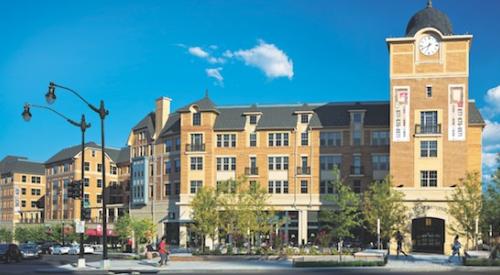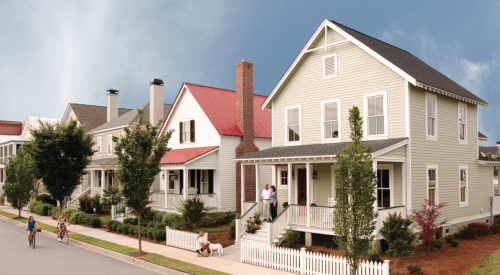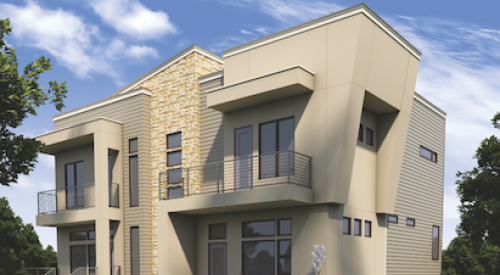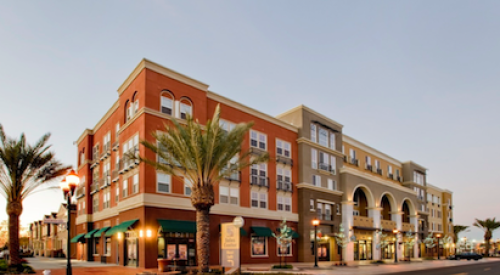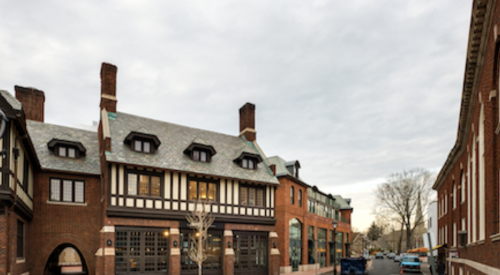|
The view from the upper lofted level of this 11th-floor unit provides a clear view of the State Capitol building to the north and the greenbelt to the south. A 12-foot ceiling opens to 20 feet in the living/dining space.
|
|
|
|
|
Beyond concrete balconies and painted steel railings, this exterior is a sculpture of mixed media. Copper-clad panels provide formal bookends; between them is a mix of corrugated Galvalume, more copper and a wall of limestone block, which screens the parking garage from view and provides a shaded loggia.
Photos by Jim Moritz |
|
|
In the kitchen, European maple veneer cabinets and hardwood flooring meet granite slab countertops and stainless steel Jenn-Air appliances. Elsewhere, the urban loft design, with its sealed concrete surfaces and exposed ducts, is similarly softened with conduit hidden inside conventional floor-to-ceiling privacy walls.
|
It took some imagination to envision a hot, upscale fill property on a former used-car lot near a trash-strewn creek bed. But CLB Partners, already having succeeded with urban infill projects in its hometown of Dallas and in Houston, found such a site in Texas' capital city, Austin, and turned their vision into reality. The resulting retail/residential project, Austin City Lofts, is tapping housing needs and helping to fuel continued residential, retail, restaurant and employment growth alongside the Central Business District.
Opportunities
Austin's downtown commercial real estate market is slowly rebounding from a glut brought on by the tech-bubble bust, but residential real estate in the area suffers from the opposite. "There was a housing shortage; they just didn't know it," says W. Bobby Nail, partner with CLB overseeing Austin City Lofts. He estimates there are 3,200 total residential units in downtown Austin, in contrast to 10,000 in downtown Memphis, a comparably sized city.
Before construction, CLB counted a paltry 400 total ownership units in downtown high rises, despite a third-party research finding that 28 percent of the 60,000 people working downtown would consider a home purchase there if housing were available.
Another indicator of the market viability of downtown high-rise living was just around the corner and 4 blocks away, at the 11-story, 95-home Nokonah condominium project, completed two years ago by developers Perry Lorenz and Robert Barnstone. Sales were "very successful," says Nail, "and we thought we could bring our product here and do very well with it." Luckily the automotive-sales site pre-sented no brownfield mitigation, Nail says. In addition, the Shoal Creek greenbelt, with its miles of dry creek bed feeding flood waters into the Colorado River, was an under-valued asset.
Obstacles
Shoal Creek was an eyesore at the outset. "Many developers would turn away from the creek," says Brett Rhode, project manager and designer at PageSutherlandPage Architects of Austin. "We took the opposite approach. We cleaned it up and oriented our building to embrace it in a big way."
The city of Austin rescinded roughly $260,000 in permits and reimbursed an additional $80,000 for lighting, landscaping and creek improvements. Some improvements were for flood mitigation included:
- designing the first floor at Austin City Lofts several feet above ground level.
- engineering the structure to 100-year flood-schedule standards.
- waterproofing the underground parking facility to 25-year standards and adding a submarine-style door.
Additionally, says Ron Cibulka, senior developer with CLB Partners and lead developer on the project, the city of Austin built a reinforced wall "as part of the flood prevention planning for our site and surrounding areas in downtown Austin."
Marketing and design challenges were only slightly less daunting. Nail characterizes Austin buyers as liberal in many ways, but very traditional compared with buyers of the company's California projects. "We were really pushing the envelope," he says.
Exposed ducts, concrete floors, open plans and high ceilings (variously 12 to 20 feet) qualify the condos as lofts. But these units also incorporate floor-to-ceiling bedroom walls, areas with hardwood floors and a high degree of finish. This architectural balancing act was the direct result of focus groups begun a year before final designs were complete.
Research also indicated a market for both younger urban buyers and suburban empty nesters willing to consider a major lifestyle shift by trading down in space, if not in price.
Designing the building's 19 floor plans was "a bit of a puzzle and a real challenge," says Rhode, "because the building's configuration changes three times as you move up through the levels."
The first four levels include a lobby, underground parking, street-front retail and management offices plus eight ground-level units overlooking the creek greenbelt and swimming pool. Levels five to 10 have 54 units with 11-foot, 4-inch ceilings and views of the state capitol to the north or of Town Lake to the south. Levels 11 to 14 host 20 two-story homes with partial second floors to allow a 20-foot high ceiling in the living room area. The upper loft units are designed to provide views both north and south.
The original concept for the building called for all two-story lofts, but market research dictated both the enclosed rooms and the creation of single-story plans on floors 1 to 11. While plans are generally similar on the lower and middle six floors, those lower units retain their own charm, says Rhode. "They have a completely different feel than the units in the mid-level because the view is entirely different. It's a little more private and secluded, with less traffic noise than levels five and up."
Outcomes
Before groundbreaking in late 2002, CLB Partners sold more than a dozen units at Austin City Lofts. Presales continued from a sales office next to the building, which housed a partial model. More than half of the 82 units were sold before models opened on April 29. By June 28, only 32 units remained.
Neal says the biggest surprise was that 80 percent of buyers are empty nesters, more than expected. Levels 5-10, priced in the middle range, are the best sellers due to their win-win compromise of a good view and the absence of stairs, which are present on the premium levels 11 and higher.
The project plays a meaningful role in Austin's efforts to encourage downtown, mixed-use development. Nail says that project team members even coined a new name for the neighborhood. "Today, when someone mentions the Market District, people immediately know where it is," says Nail.
Shoal Creek is no longer undervalued. "When people walk by, they go, 'Wow!' It's a huge amenity," says Nail, adding that the view of the creek helps sales of lower-level units, which lack a skyline view.
We're looking for top-selling, high-design projects to feature. Tell us about your great homes and communities at mstromberg@reedbusiness.com.
